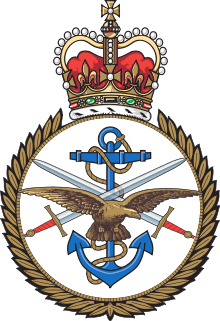Permanent Joint Headquarters
The Permanent Joint Headquarters (PJHQ) is the British tri-service headquarters from where all overseas military operations are planned and controlled. It is situated at Northwood Headquarters in Northwood, London. The Permanent Joint Headquarters is commanded by the Chief of Joint Operations (CJO) and the current CJO is Vice Admiral Ben Key.[1]
| Permanent Joint Headquarters | |
|---|---|
 | |
| Active | 1996–present |
| Country | |
| Branch | |
| Type | Command |
| Part of | Joint Forces Command |
| Garrison/HQ | Eastbury, Hertfordshire |
| Commanders | |
| Current commander | Vice Admiral Ben Key |
_at_Northwood_MOD_45152478.jpg)
History
Major General Christopher Wallace led the team that began establishing the headquarters from 1994.[2] "Senior officers in the Army and RAF did not welcome this initiative and Wallace had to deploy his considerable skills of advocacy to win that battle"[2] (to establish the new joint headquarters).
The Permanent Joint Headquarters was established on 1 April 1996 to enhance the operational effectiveness and efficiency of UK-led joint, potentially joint and multi-national operations, and to exercise operational command of UK forces assigned to multinational operations led by others.[3] Wallace was appointed as CJO in the rank of lieutenant general. The PJHQ started to assume responsibility for military operations worldwide (fully operational) on 1 August 1996.[4] The 35-hectare Northwood Headquarters site has belonged to the RAF since 1938.[5]
By mid-1998, a short-notice deployable headquarters commanded by a Brigadier-equivalent officer, the Joint Force Headquarters (JFHQ) was being established within PJHQ. The JFHQ was an outgrowth of the PJHQ's J3 Operations staff. The JFHQ was described as 'capable of deploying into the field at very short notice,' by its first commander, Brigadier David Richards. Richards was appointed as Chief Joint Rapid Deployment Force Operations, and also to expand the concept that underpinned its creation, the Joint Rapid Reaction Forces.[6] The JRRFs were to be "a pool of highly capable force elements, maintained at high and very high readiness,"[7] from which the UK was to meet all short notice contingencies. Initially planned to have a staff of 24, Richards expanded the JFHQ to 55 strong, 'something our training and experience on exercise was proving necessary.'[8]
In 2007-2008, the PJHQ' s budget was estimated around £475 million.[4]
In 2010, the PJHQ and its 600 staff officers and enlisted personnel moved to a contemporary building in Northwood, London.[9][10] For the first time, all PJHQ agents were gathered under the same roof.[5]
In January 2013, the PJHQ was considering the launch of a show of force amid the Argentina-UK conflict over the Falkland Islands.[11]
Mission and duties
The PJHQ's mission is as follows:[12]
"CJO is to exercise operational command of UK forces assigned to overseas joint and combined operations; and to provide politically aware military advice to the MOD in order to achieve MOD UK’s strategic objectives on operations"
There are certain areas that the headquarters was not and will not be involved in:[12]
- Strategic Nuclear Deterrent
- Defence of the UK Home Base, Territorial Waters and Airspace
- Northern Ireland
- Counter-terrorism in UK (Home Office)
- NATO Article V (General War) (NATO Military Command Structure)
The cyber operations are co-jointly handled by the Government Communications Headquarters in Cheltenham and the PJHQ in Northwood.[13]
Commanders
The Chief of Joint Operations (CJO) is the appointment held by the 3*-ranked Officer that leads PJHQ.[14]
| April 1996 | Lieutenant General | Sir Christopher Wallace |
| February 1999 | Vice Admiral | Sir Ian Garnett |
| August 2001 | Lieutenant General | Sir John Reith |
| 26 July 2004 | Air Marshal | Sir Glenn Torpy |
| March 2006 | Lieutenant General | Sir Nicholas Houghton |
| 13 March 2009 | Air Marshal | Sir Stuart Peach |
| December 2011 | Lieutenant General | Sir David Capewell |
| January 2015 | Lieutenant General | Sir John Lorimer |
| June 2017 | Vice Admiral | Timothy Fraser |
| April 2019 | Vice Admiral | Ben Key |
See also
References
- "Final Royal Navy helicopter returns from Oman". Royal Navy. 15 April 2019. Retrieved 15 April 2019.
- "Lieutenant General Sir Christopher Wallace – obituary". The Telegraph. 2 February 2016. Retrieved 7 April 2016.
- "Permanent Joint Headquarters". Armed Forces. Retrieved 22 May 2014.
- "Armed Forces - m06 - Permanent Joint Headquarters(PJHQ) - Overview of International Operations - Headquarters Structure - PJHQ Headquarters Structure - Lt General J N Houghton". www.armedforces.co.uk. Retrieved 2019-06-02.
- "Ministry of Defence | About Defence | What we do | Doctrine Operations and Diplomacy | PJHQ | PJHQ - History". webarchive.nationalarchives.gov.uk. Retrieved 2019-06-02.
- Anthony Stone, 'Joint approach to defence: Three into One Will Go,' Soldier magazine, May 1999, 36, and General David Richards, 'Taking Command: The Autobiography,' Headline Publishing Group, 2014, 95-97.
- PJHQ Brief circa July 2000, via liaison officer at PJHQ
- Richards 2014, 99.
- Wyatt, Caroline (2010-08-07). "Rare look at UK's 'Cell Block H'". Retrieved 2019-06-02.
- "Queen opens military headquarters". 2010-05-06. Retrieved 2019-06-02.
- "Britain preparing for new Falklands War?". RT International. Retrieved 2019-06-02.
- "The Permanent Joint Headquarters". gov.uk. Retrieved 2009-02-07.
- Earl, Nicholas (2018-09-21). "UK to form new cyber force to combat Russian hacking". www.cityam.com. Retrieved 2019-06-02.
- Modernising Defence: Implementing the Strategic Defence Review 30 March 1999
- Vice Admiral Sir Ian Garnett, "My Job: The Challenge of Joint Command," RUSI Journal, August 1999
- Vice Admiral Sir Ian Garnett, "PJHQ: The Heart of UK Defence Capability," RUSI Journal, April 2000